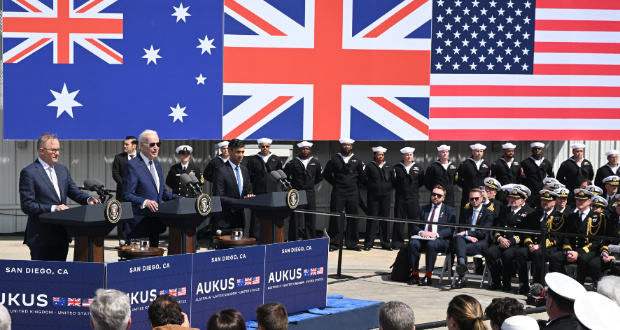In the last twelve months, the three partners in the Australia–United Kingdom–United States (AUKUS) partnership have made significant strides in their core or Pillar 1 ambition to jointly create a nuclear-powered-submarine capability for the Royal Australian Navy (RAN). That ambition includes combining to produce a new SSN-AUKUS submarine, derived from a UK design, that will also serve in the Royal Navy. There is also an increased focus on the so-called Pillar 2 effort to cooperate on a range of other advanced defence technologies. That has included opening the door ever so slightly to the prospects of cooperation with other countries, notably Japan. But, in many ways, all these activities have served only to underscore the scale of the challenges ahead.
Sub-optimal approach
AUKUS is in many ways a giant balancing act between risk and strategic reward for all three countries. It is also a balance between seeking to add to Indo-Pacific deterrence and stability and not stoking further tensions. In addition, it is attempting to manage urgent defence and operational needs with long-term capability goals. And the partners need to ensure the huge budgetary demands of AUKUS do not suck up too much funding at the expense of other defence requirements.
At the end of 2023, perhaps against expectation, the US Congress passed a National Defense Authorization Act (NDAA) that included important AUKUS-related provisions. On the submarine front, it supposedly cleared the way for the sale of at least three US Virginia-class submarines from the early 2030s to get an RAN nuclear-powered-submarine force under way.

However, US shipyards are still producing only around 1.3 Virginia-class boats per year, well short of the 2.3 boats deemed necessary to satisfy both US Navy and RAN demands. To compound concerns, in March the Biden administration’s latest defence-budget request included only one Virginia class for next year. And the coming years will see some of the greatest challenges in terms of the overall size of the US submarine forces and its readiness.
Australia has underscored commitments to invest in both the US and UK industries to help expand capacity. Even so, there remain questions over whether that will be enough, not least as all three countries face challenges in generating the necessary increases in their skilled workforces. And, while Australian personnel are already training with the US and Royal navies to prepare to crew their first nuclear-powered submarines, even now some shortcuts will be needed to produce enough personnel by the early 2030s.




